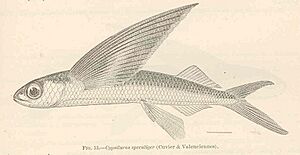Mirrorwing flyingfish facts for kids
Quick facts for kids Mirrorwing flyingfish |
|
|---|---|
 |
|
| Conservation status | |
| Scientific classification | |
| Synonyms | |
|
The mirrorwing flyingfish (Hirundichthys speculiger) is a cool type of flying fish. It belongs to a group of fish called Exocoetidae, which are known for their amazing ability to glide through the air! A French scientist named Achille Valenciennes first described this fish in 1847. He wrote about it in a huge book series called Natural History of Fishes.
What Does the Mirrorwing Flyingfish Look Like?
The mirrorwing flyingfish has special fins that help it fly! Its back fin (called the dorsal fin) has 10 to 12 soft rays. The fin on its belly (the anal fin) has 11 to 13 rays.
Its body is usually dark blue on top and shiny silver-white underneath. This helps it blend in with the ocean. The dorsal fin and tail fin (called the caudal fin) are grayish. Other fins are clear, like glass.
Young mirrorwing flyingfish look a bit different. They have longer bodies and their fins have a spotted pattern. Adult fish can grow up to 30 centimeters (about 1 foot) long. However, they are usually around 24 centimeters (about 9 inches) long.
Where Do Mirrorwing Flyingfish Live?
Mirrorwing flyingfish live in warm ocean waters all over the world. They are most common in tropical and mild areas.
In the Atlantic Ocean, you can find them in tropical parts of the east. They also live along the coasts of North America and South America. However, they are not often seen in the Gulf of Guinea, Caribbean Sea, or Gulf of Mexico. It's also interesting that they are not found in the Benguela Current.
In the Indian Ocean, these fish are found near South Africa, Mauritius, Rodrigues, the Maldives, and the Chagos Archipelago. In the Pacific Ocean, they live in most areas, except for the seas of Southeast Asia.
How Do Mirrorwing Flyingfish Reproduce?
Mirrorwing flyingfish reproduce all year long in the open ocean. This is where they normally live. They lay their eggs in large groups. These eggs stick to floating trash or plants in the water.
The eggs have special thin threads, like tiny strings. These threads help the eggs attach to things. Scientists can even tell if eggs belong to a mirrorwing flyingfish by looking at how these threads are arranged.


